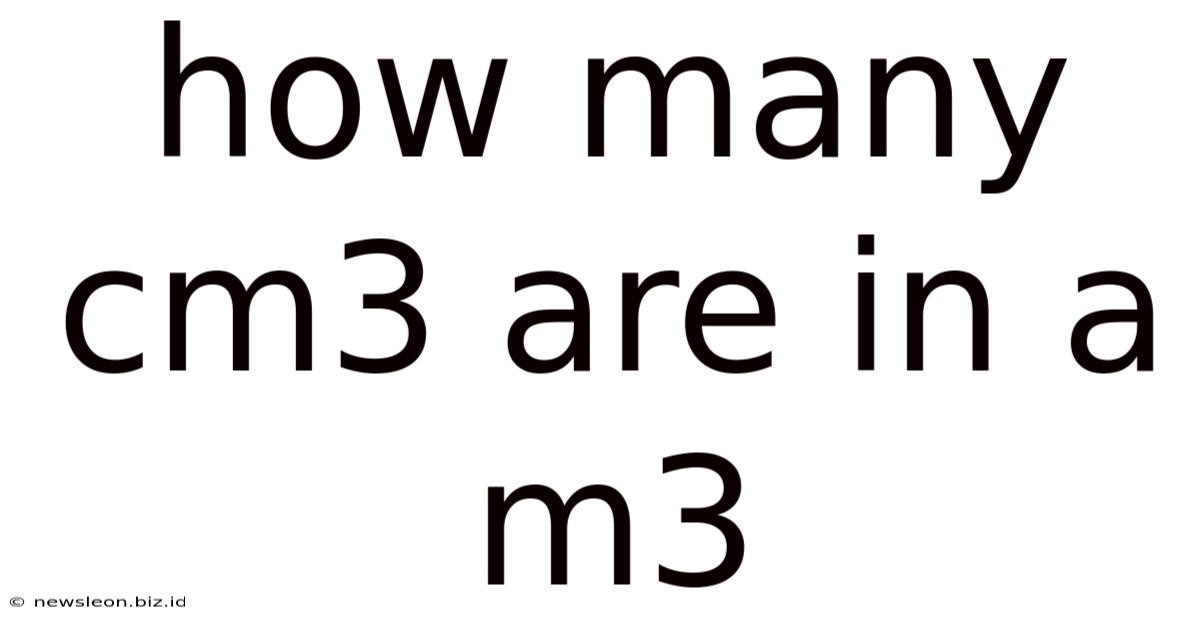How Many Cm3 Are In A M3
News Leon
May 05, 2025 · 4 min read

Table of Contents
How Many cm³ Are in a m³? A Comprehensive Guide to Cubic Measurements
Understanding cubic measurements is crucial in various fields, from engineering and construction to medicine and everyday life. This comprehensive guide will delve deep into the conversion between cubic centimeters (cm³) and cubic meters (m³), explaining the process, providing practical examples, and exploring the broader implications of understanding these units. We’ll also touch on related units and conversions to solidify your understanding.
Understanding Cubic Units
Before diving into the conversion, let's establish a clear understanding of cubic units. A cubic unit represents the volume of a cube with sides of a specific length. For example:
- Cubic centimeter (cm³): Represents the volume of a cube with sides measuring 1 centimeter each.
- Cubic meter (m³): Represents the volume of a cube with sides measuring 1 meter each.
The key difference lies in the scale. A meter is 100 centimeters, which significantly impacts the volume comparison. This is where the conversion factor comes into play.
The Conversion: From cm³ to m³ and Vice Versa
The fundamental relationship between centimeters and meters is that 1 meter = 100 centimeters. However, this is a linear relationship. When dealing with volume (a three-dimensional measurement), we need to cube this relationship.
Therefore, the conversion factor is:
(1 m)³ = (100 cm)³ => 1 m³ = 1,000,000 cm³
This means that one cubic meter contains one million cubic centimeters. This is a vital piece of information to remember and apply in various conversions.
Practical Applications and Real-World Examples
The conversion between cm³ and m³ is relevant in many practical situations. Here are a few examples:
1. Calculating the Volume of Liquids
Imagine you need to calculate the volume of water in a large tank. The tank's dimensions are given in meters (e.g., length = 2m, width = 1.5m, height = 1m). Calculating the volume in cubic meters is straightforward (2m * 1.5m * 1m = 3m³). To express this in cubic centimeters, simply multiply by 1,000,000:
3 m³ * 1,000,000 cm³/m³ = 3,000,000 cm³
2. Measuring the Volume of Solids
Suppose you have a block of concrete with dimensions given in centimeters (e.g., length = 50cm, width = 30cm, height = 20cm). The volume in cubic centimeters is easily calculated (50cm * 30cm * 20cm = 30,000 cm³). To convert this to cubic meters, divide by 1,000,000:
30,000 cm³ / 1,000,000 cm³/m³ = 0.03 m³
3. Understanding Packaging and Shipping
In logistics and shipping, understanding cubic measurements is essential. Packaging dimensions are often given in centimeters, while shipping costs might be calculated based on cubic meters. The ability to accurately convert between these units ensures correct cost calculations and efficient packaging.
Beyond cm³ and m³: Exploring Other Cubic Units
While cm³ and m³ are common, other cubic units exist, often used depending on the scale of measurement:
- Cubic millimeters (mm³): Used for extremely small volumes, often in microscopy or material science. 1 cm³ = 1000 mm³.
- Cubic kilometers (km³): Used for extremely large volumes, often in geography or geology. 1 m³ = 0.000000001 km³.
- Liters (L): A metric unit of volume equal to 1000 cm³ or 1 dm³. This is frequently used for liquids and gases.
- Gallons (gal): An imperial unit of volume; its cubic metric equivalent varies depending on the specific type of gallon (US liquid gallon vs. imperial gallon).
Mastering Unit Conversions: Tips and Techniques
Mastering unit conversions involves more than just memorizing formulas. It requires a solid grasp of the underlying principles and a systematic approach. Here are some tips:
- Understand the Relationships: Clearly understand the relationships between different units. For instance, the relationship between centimeters and meters is fundamental to understanding the cubic conversion.
- Use Conversion Factors: Conversion factors are crucial. Always write them down explicitly to avoid errors. Make sure the units cancel out correctly in your calculations.
- Break Down Complex Conversions: For multi-step conversions, break the process into smaller, manageable steps. This reduces the chance of errors and makes the calculation easier to follow.
- Check Your Units: Always double-check your units at each step. Ensure they are consistent and cancel out appropriately. Incorrect units are a common source of errors.
- Practice Regularly: The best way to master unit conversions is through regular practice. Work through various examples and problems to build your confidence and proficiency.
The Importance of Precision in Measurements
Accuracy in measurements is paramount, especially in fields like engineering and construction where even small errors can have significant consequences. Using the correct units and conversion factors ensures the precision necessary for successful outcomes.
Conclusion: A Foundation for Further Learning
Understanding the conversion between cm³ and m³ is a fundamental step in mastering volume calculations. It’s a crucial skill applicable across numerous disciplines and everyday situations. This comprehensive guide has equipped you with the knowledge and tools to confidently perform these conversions and apply them in various contexts. As you continue to explore more complex calculations and units, remember the importance of precision, systematic approaches, and consistent unit checking. This strong foundation will serve you well in future endeavors.
Latest Posts
Related Post
Thank you for visiting our website which covers about How Many Cm3 Are In A M3 . We hope the information provided has been useful to you. Feel free to contact us if you have any questions or need further assistance. See you next time and don't miss to bookmark.